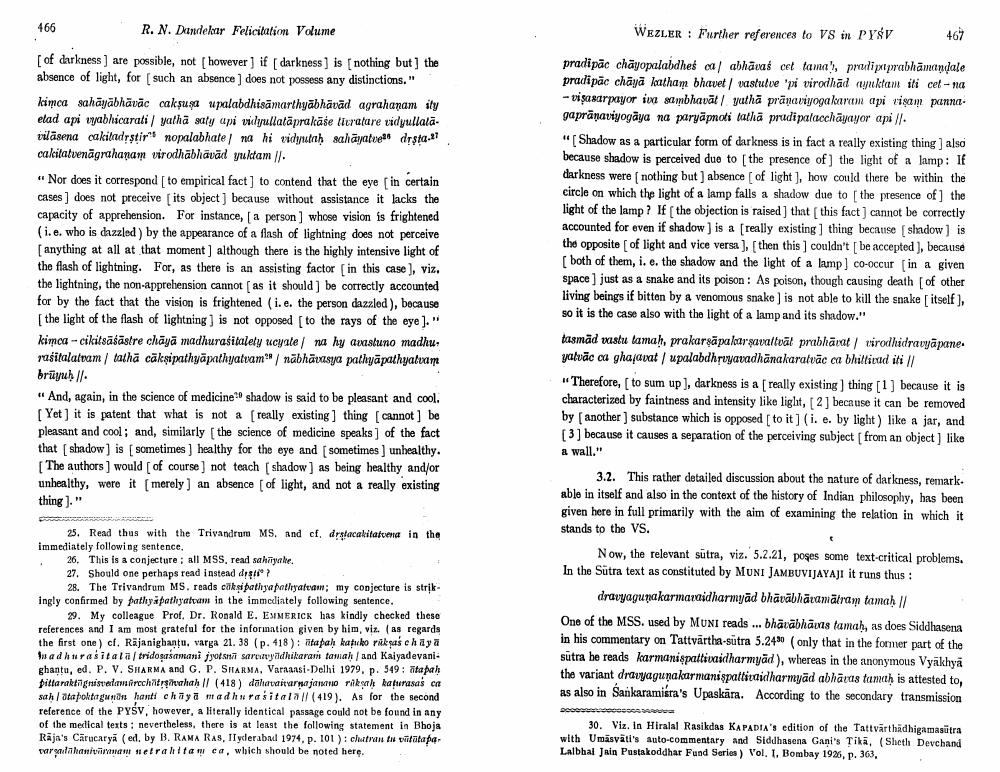Book Title: Further References To Vaisesika Sutra In Patanjala Yogasastra Vivarana Author(s): A Wezler Publisher: A Wezler View full book textPage 6
________________ 466 R. N. Dandekar Felicitation Volume [of darkness] are possible, not [however] if [ darkness] is [nothing but] the absence of light, for [such an absence ] does not possess any distinctions." kimca sahāyābhāvāc cakṣuşa upalabdhisāmarthyābhāvād agrahanam ity etad api vyabhicarati / yatha saty api vidyullataprakase titratare vidyullatavilasena cakitadṛṣṭir's nopalabhate na hi vidyutaḥ sahayatves dṛṣṭa. calitatvenägrahanam virodhābhāvād yuktam . "Nor does it correspond [ to empirical fact] to contend that the eye [in certain cases] does not preceive [its object] because without assistance it lacks the capacity of apprehension. For instance, [a person] whose vision is frightened (i.e. who is dazzled) by the appearance of a flash of lightning does not perceive [anything at all at that moment] although there is the highly intensive light of the flash of lightning. For, as there is an assisting factor [in this case], viz. the lightning, the non-apprehension cannot [ as it should] be correctly accounted for by the fact that the vision is frightened (i. e. the person dazzled), because [the light of the flash of lightning] is not opposed [to the rays of the eye]." kimca-cikitsäsästre chāyā madhuraśitalety ucyate na hy avastuno madhu rasitalatvam tatha cākṣipathyapathyatvam nabhavasya pathyapathyatvam brüyuk }}. "And, again, in the science of medicine20 shadow is said to be pleasant and cool. [Yet] it is patent that what is not a [really existing] thing [cannot] be pleasant and cool; and, similarly [the science of medicine speaks] of the fact that [shadow] is [sometimes] healthy for the eye and [sometimes] unhealthy. [The authors] would [of course] not teach [shadow] as being healthy and/or unhealthy, were it [merely] an absence [of light, and not a really existing thing]." 25. Read thus with the Trivandrum MS. and ef, dratacakitatvena in the immediately following sentence. 26. This is a conjecture; all MSS, read sahiyake. 27. Should one perhaps read instead dṛşti"? 28. The Trivandrum MS. reads cäksipathyapathyatvam; my conjecture is strikingly confirmed by pathyapathyatvam in the immediately following sentence. 29. My colleague Prof. Dr. Ronald E. EMMERICK has kindly checked these references and I am most grateful for the information given by him, viz. (as regards the first one) cf. Rajanighantu, varga 21. 38 (p. 418): tapaḥ katuko rūkṣas chāyā madhurasitala tridosasamani jyotsna sarvavyādhikaram tamah | and Kaiyadevanighantu, ed. P. V. SHARMA and G. P. SHARMA, Varaaasi-Delhi 1979, p. 549: tapaḥ pittaraktignisvedamirechitṛṣiwahah || (418) dahavaivarṇajanano rakṣaḥ katurasas ca sah atapoktagunan hanti chaya madhurasitala (419). As for the second reference of the PYSV, however, a literally identical passage could not be found in any of the medical texts; nevertheless, there is at least the following statement in Bhoja Raja's Carucarya (ed. by B. RAMA RAS, IIyderabad 1974, p. 101): chatran tu vitutapa varzadāhanivāraṇam netrahitam ca, which should be noted here. WEZLER: Further references to VS in PYSV pradipac chayopalabdheś ca abhavas cet tama, pradipaprabhāmaṇḍale pradipäc chāyā katham bhavet / vastutve 'pi virodhad ayuktam iti cet-na -visasarpayor iva sambhavat yatha pranaviyogakaram api risam panna. gaprānaviyogaya na paryäpnoti tatha pradipalacchayayor api //. 467 "[Shadow as a particular form of darkness is in fact a really existing thing] also because shadow is perceived due to [the presence of] the light of a lamp: If darkness were [nothing but ] absence [ of light], how could there be within the circle on which the light of a lamp falls a shadow due to [the presence of] the light of the lamp? If [the objection is raised] that [this fact] cannot be correctly accounted for even if shadow ] is a [really existing] thing because [shadow] is the opposite [of light and vice versa ], [ then this ] couldn't [ be accepted ], because [both of them, i. e. the shadow and the light of a lamp] co-occur [in a given space] just as a snake and its poison: As poison, though causing death [of other living beings if bitten by a venomous snake ] is not able to kill the snake [ itself], so it is the case also with the light of a lamp and its shadow." tasmad vastu tamaḥ, prakarṣāpakarsavaltvat prabhāvat virodhidravyāpane. yalvāc ca ghajavat / upalabdhṛvyavadhanakaratvac ca bhittivad iti // "Therefore, [to sum up ], darkness is a [ really existing ] thing [1] because it is characterized by faintness and intensity like light, [2] because it can be removed by [another] substance which is opposed [ to it ] (i. e. by light) like a jar, and [3] because it causes a separation of the perceiving subject [ from an object] like a wall." 3.2. This rather detailed discussion about the nature of darkness, remark. able in itself and also in the context of the history of Indian philosophy, has been given here in full primarily with the aim of examining the relation in which it stands to the VS. Now, the relevant sutra, viz. 5.2.21, poses some text-critical problems. In the Sutra text as constituted by MUNI JAMBUVIJAYAJI it runs thus: dravyaguṇakarmavaidharmyād bhāvābhāvamātram tamaḥ || One of the MSS. used by MUNI reads... bhāvābhāvas tamaḥ, as does Siddhasena in his commentary on Tattvärtha-sütra 5.2430 (only that in the former part of the sutra he reads karmanispattivaidharmyad), whereas in the anonymous Vyakhya the variant dravyaguṇakarmanispattivaidharmyad abhāras tamah is attested to, as also in Sankaramiśra's Upaskāra. According to the secondary transmission pa 30. Viz. in Hiralal Rasikdas KAPADIA's edition of the Tattvärthadhigamasutra with Umäsväti's auto-commentary and Siddhasena Gani's Tikā, (Sheth Devchand Lalbhal Jain Pustakoddhar Fund Series) Vol. I, Bombay 1926, p. 363,Page Navigation
1 ... 4 5 6 7 8 9
